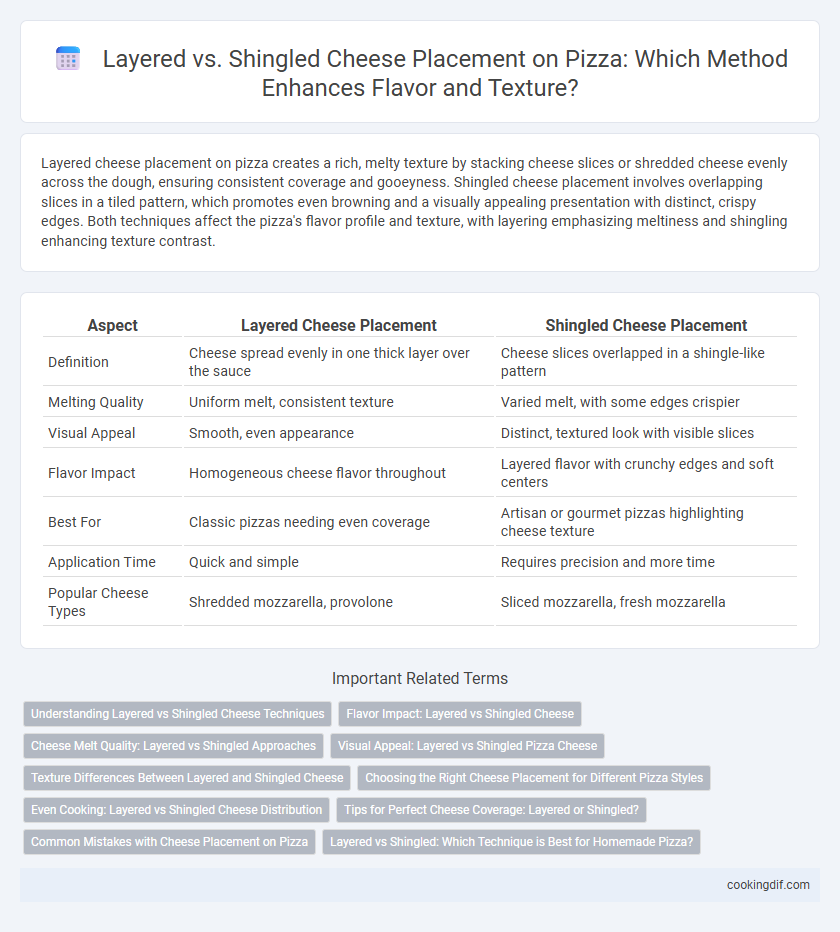Layered cheese placement on pizza creates a rich, melty texture by stacking cheese slices or shredded cheese evenly across the dough, ensuring consistent coverage and gooeyness. Shingled cheese placement involves overlapping slices in a tiled pattern, which promotes even browning and a visually appealing presentation with distinct, crispy edges. Both techniques affect the pizza's flavor profile and texture, with layering emphasizing meltiness and shingling enhancing texture contrast.
Table of Comparison
| Aspect | Layered Cheese Placement | Shingled Cheese Placement |
|---|---|---|
| Definition | Cheese spread evenly in one thick layer over the sauce | Cheese slices overlapped in a shingle-like pattern |
| Melting Quality | Uniform melt, consistent texture | Varied melt, with some edges crispier |
| Visual Appeal | Smooth, even appearance | Distinct, textured look with visible slices |
| Flavor Impact | Homogeneous cheese flavor throughout | Layered flavor with crunchy edges and soft centers |
| Best For | Classic pizzas needing even coverage | Artisan or gourmet pizzas highlighting cheese texture |
| Application Time | Quick and simple | Requires precision and more time |
| Popular Cheese Types | Shredded mozzarella, provolone | Sliced mozzarella, fresh mozzarella |
Understanding Layered vs Shingled Cheese Techniques
Layered cheese placement involves stacking uniform cheese slices directly atop each other, creating a thick, evenly melted texture that enhances flavor density. Shingled cheese technique arranges overlapping slices in a pattern resembling roof shingles, promoting even heat distribution and a visually appealing, crispy edge on each slice. Understanding the differences between layered and shingled methods allows pizza makers to control melt consistency and achieve desired texture and presentation.
Flavor Impact: Layered vs Shingled Cheese
Layered cheese placement creates a rich, creamy texture as the cheese melts uniformly, blending flavors seamlessly with the sauce and toppings. Shingled cheese slices develop a slightly crispy edge with more distinct, individual melted pieces, enhancing flavor complexity and providing textural contrast. Choosing between layered and shingled cheese affects the pizza's overall flavor profile and mouthfeel, making it crucial for customizing taste experiences.
Cheese Melt Quality: Layered vs Shingled Approaches
Layered cheese placement evenly distributes heat, promoting thorough melting and a smooth, cohesive texture across the pizza surface. Shingled cheese placement allows each slice to melt independently, resulting in distinct, slightly firmer edges with varied browning. The layered approach maximizes gooey melt quality, while shingling enhances visual appeal and controlled browning for artisanal presentation.
Visual Appeal: Layered vs Shingled Pizza Cheese
Layered cheese on pizza creates a thick, uniform melt that enhances gooey texture but can obscure toppings, offering a dense visual appeal. Shingled cheese placement results in overlapping slices that expose more sauce and toppings, producing a more artisanal, textured look. Shingled arrangements better highlight the pizza's ingredients by balancing melted cheese coverage with visual variety.
Texture Differences Between Layered and Shingled Cheese
Layered cheese placement creates a denser, creamier texture as the cheese melts uniformly, blending smoothly with the sauce and toppings. Shingled cheese allows for more surface area exposure, resulting in a slightly crispier, browned edge that adds a subtle crunch. These textural differences significantly influence the overall mouthfeel and flavor experience of the pizza.
Choosing the Right Cheese Placement for Different Pizza Styles
Layered cheese placement evenly distributes mozzarella over the entire pizza, creating a uniform melt ideal for thick-crust styles like Chicago deep-dish. Shingled cheese placement overlaps slices or pieces, promoting browning and texture variance perfect for thin-crust and Neapolitan pizzas. Selecting the right method enhances flavor balance and texture, ensuring optimal cheese melt and bite consistency for each pizza style.
Even Cooking: Layered vs Shingled Cheese Distribution
Layered cheese placement creates a thick, uniform melting surface that may result in uneven heat penetration and occasional undercooked spots. Shingled cheese distribution allows for better airflow and heat circulation, promoting consistent melting and even cooking across the pizza. Achieving optimal cheese texture and flavor depends on choosing a method that balances coverage with efficient heat transfer.
Tips for Perfect Cheese Coverage: Layered or Shingled?
For perfect cheese coverage on pizza, layered placement ensures even melting and a consistent gooey texture by stacking slices or shredded cheese uniformly across the dough. Shingled cheese arrangement, where slices slightly overlap like roof shingles, promotes a visually appealing, slightly crispy edge with distinct cheese bites. Choose layered for smooth, melty coverage or shingled to enhance texture contrast and presentation.
Common Mistakes with Cheese Placement on Pizza
Common mistakes in cheese placement on pizza include uneven layering that causes inconsistent melting and pockets of undercooked cheese. Overlapping cheese in a shingled pattern can result in overly thick cheese zones that fail to cook thoroughly and create greasy spots. Ensuring even distribution by balancing layering and shingling techniques promotes uniform heat exposure, optimal melt, and consistent texture across the pizza.
Layered vs Shingled: Which Technique is Best for Homemade Pizza?
Layered cheese placement on homemade pizza creates a rich, gooey texture by stacking slices or shredded cheese evenly across the dough, ensuring consistent melting and flavor distribution. Shingled cheese placement involves overlapping slices like roof tiles, which allows for better browning and a slightly crispier texture on each piece. Choosing between layered and shingled depends on desired texture: layered yields a creamy, unified cheese layer, while shingled offers more distinct, caramelized cheese edges.
Layered vs Shingled for cheese placement Infographic

 cookingdif.com
cookingdif.com